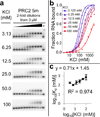Promiscuous RNA binding by Polycomb repressive complex 2
- PMID: 24077223
- PMCID: PMC3823624
- DOI: 10.1038/nsmb.2679
Promiscuous RNA binding by Polycomb repressive complex 2
Abstract
Polycomb repressive complex 2 (PRC2) is a histone methyltransferase required for epigenetic silencing during development and cancer. Long noncoding RNAs (lncRNAs) recruit PRC2 to chromatin, but the general role of RNA in maintaining repressed chromatin is unknown. Here we measure the binding constants of human PRC2 to various RNAs and find comparable affinity for human lncRNAs targeted by PRC2 as for irrelevant transcripts from ciliates and bacteria. PRC2 binding is size dependent, with lower affinity for shorter RNAs. In vivo, PRC2 predominantly occupies repressed genes; PRC2 is also associated with active genes, but most of those are not regulated by PRC2. These findings support a model in which PRC2's promiscuous binding to RNA transcripts allows it to scan for target genes that have escaped repression, thus leading to maintenance of the repressed state. Such RNAs may also provide a decoy for PRC2.
Figures








Comment in
-
Poly-combing the genome for RNA.Nat Struct Mol Biol. 2013 Dec;20(12):1344-6. doi: 10.1038/nsmb.2728. Nat Struct Mol Biol. 2013. PMID: 24304912
-
RNA binding of PRC2: promiscuous or well ordered?Mol Cell. 2014 Jul 17;55(2):157-8. doi: 10.1016/j.molcel.2014.07.002. Mol Cell. 2014. PMID: 25038410
References
-
- Cao R, Zhang Y. SUZ12 is required for both the histone methyltransferase activity and the silencing function of the EED-EZH2 complex. Mol Cell. 2004;15:57–67. - PubMed
-
- Yuan W, et al. Dense chromatin activates Polycomb repressive complex 2 to regulate H3 lysine 27 methylation. Science. 2012;337:971–975. - PubMed
Publication types
MeSH terms
Substances
Associated data
- Actions
Grants and funding
LinkOut - more resources
Full Text Sources
Other Literature Sources
Molecular Biology Databases

